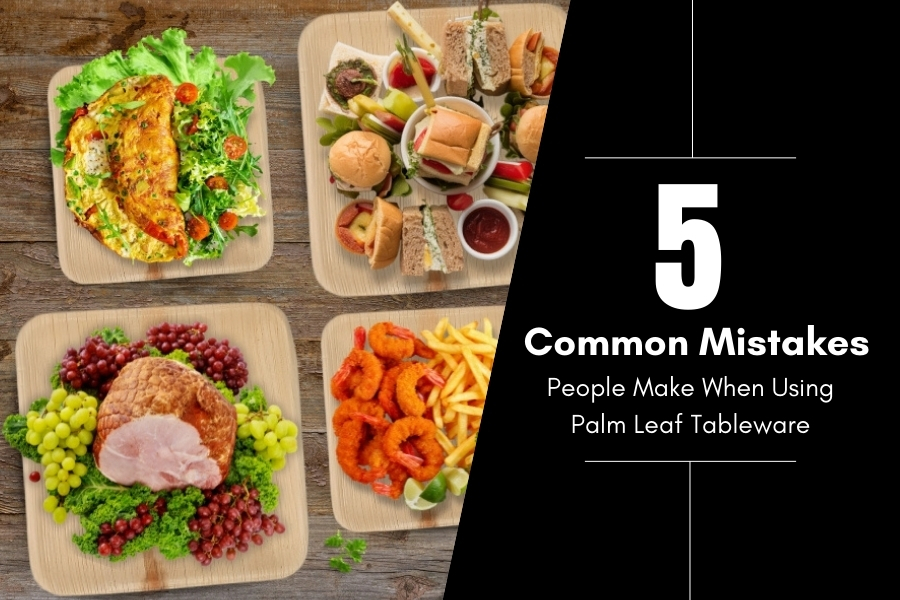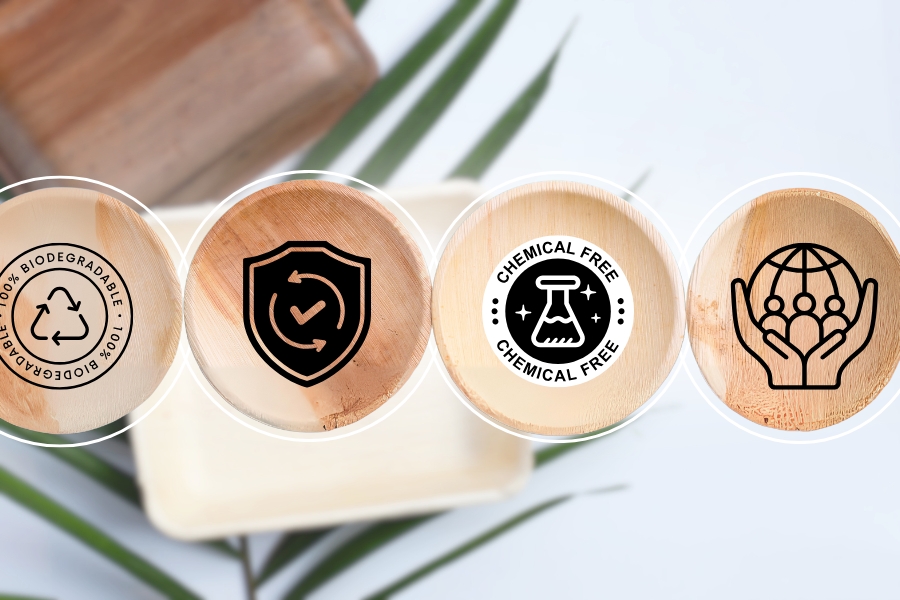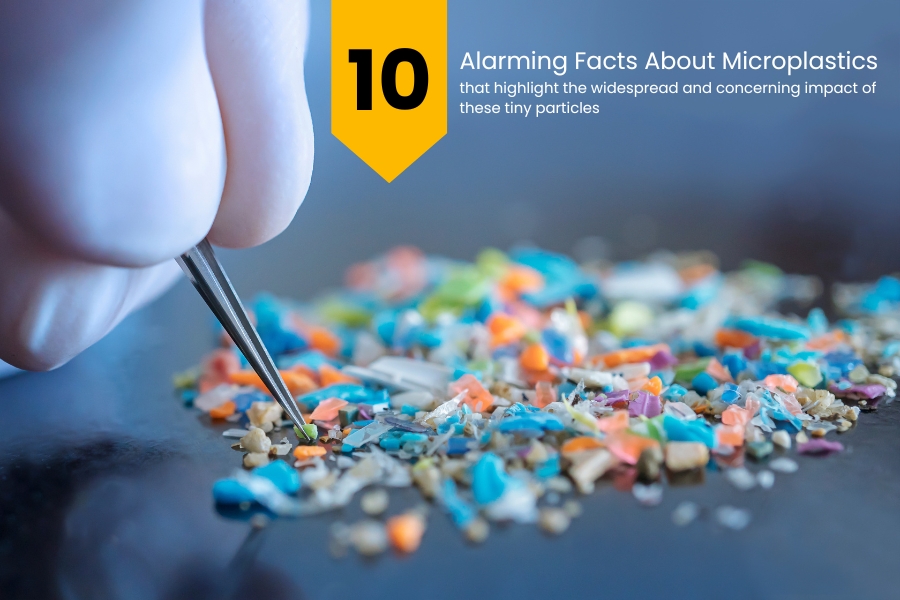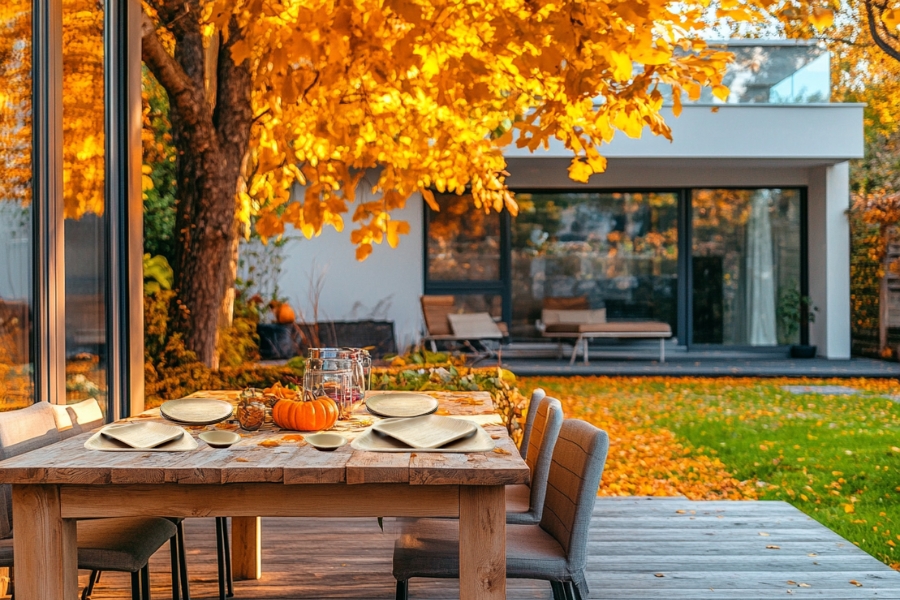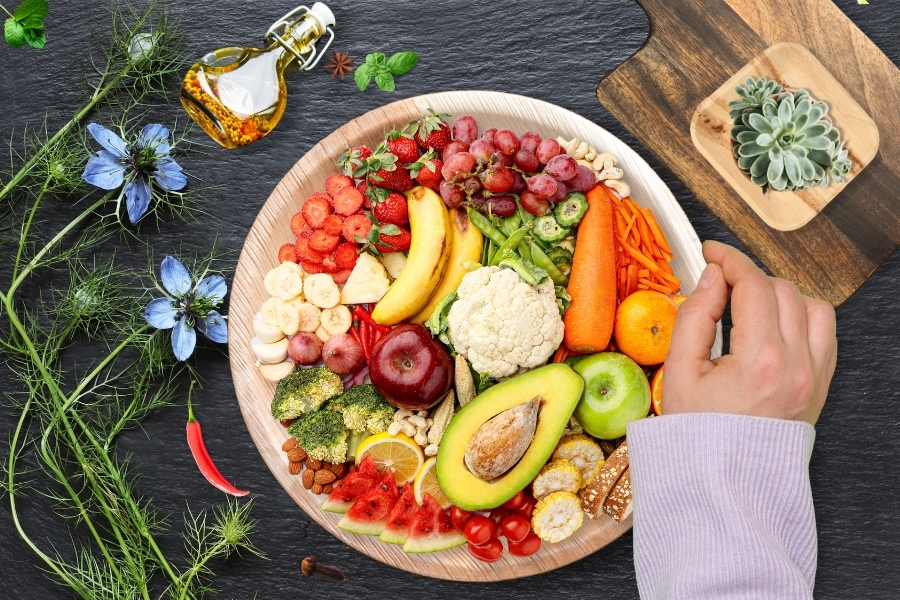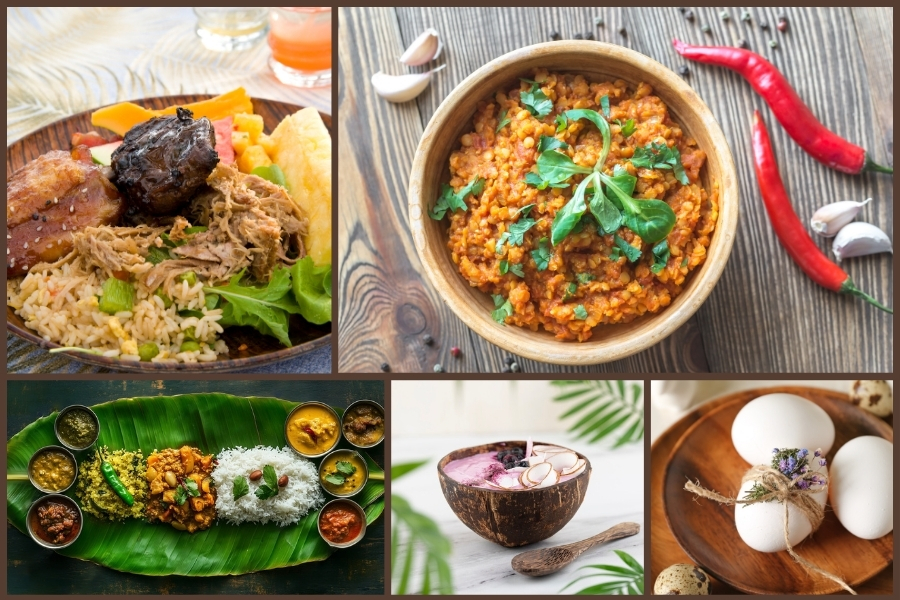Why Plastic-Free Tableware Matters? Switch to plastic-free tableware for a healthier planet! Reduce waste, avoid toxins, and enjoy stylish, eco-friendly dining options. Make the change today! Sustainability is becoming a top priority, and even small changes can make a big difference. One of the easiest yet most effective steps you can take is switching from plastic tableware to eco-friendly alternatives. While it may seem like a minor adjustment, the benefits go far beyond just reducing waste. Plastic-free tableware not only helps the environment but also supports a healthier lifestyle. Many plastics contain harmful chemicals that can leach into food, especially when heated. By choosing materials like bamboo, glass, or stainless steel, you avoid exposure to toxins while enjoying stylish and functional dining options. If you’re wondering why this switch is worth making, here are the top five reasons to embrace plastic-free tableware today. Did you know that plastic tableware makes up a significant portion of restaurant waste? 1. A Win for the Planet Plastic pollution is a growing global crisis. According to the United Nations Environment Programme (UNEP), plastics account for at least 85% of total marine waste. This waste often ends up in landfills and oceans, taking hundreds of years to decompose. By switching to biodegradable tableware, compostable dinnerware, or reusable tableware, you help reduce the massive environmental impact of plastic waste. Unlike plastic, which lingers for centuries, eco-friendly disposable plates break down naturally. For example, biodegradable plates and bowls made from palm tree tableware decompose within 180 days, significantly reducing waste. According to the United Nations Development Programme (UNDP), the world produces approximately 430 million metric tons of new plastic annually. If current trends continue, global plastic use is projected to nearly triple by 2060. Alarmingly, about 79% of the world’s plastic waste has accumulated in landfills or the natural environment, with only less than 10% being recycled. This accumulation poses significant threats to ecosystems, wildlife, and human health. Did you know your dinnerware could be exposing you to harmful toxins? 2. Toxin-Free Dining Plastic tableware isn’t just bad for the planet—it can harm your health too. Many plastics contain toxic chemicals that can leach into food, especially when heated. Researchers have found plastic particles throughout the human body, including in people’s lungs, breast milk, and blood. From oil extraction and plastic production to product use, recycling, and disposal, harmful substances can be released and disrupt our immune and hormone systems, cause cancers, or result in other health impacts. Switching to non-toxic tableware means you and your family can enjoy meals without worrying about harmful substances. Unlike plastic, biodegradable tableware made from bamboo, palm tree tableware, and glass is free from chemical binders and safe for microwave, oven, and freezer use. Fact Check: According to the United Nations Development Programme (UNDP), plastic poses risks to human health at every stage of its lifecycle, with researchers finding plastic particles throughout the human body, including in people’s lungs, breast milk, and blood. Who says sustainability can’t be stylish? 3. Stylish & Aesthetic Upgrade Plastic-free tableware often boasts sleek, natural textures and elegant colors that enhance your dining experience. Unlike dull plastic plates, these options elevate the presentation of your meals while being environmentally responsible. Looking for stunning tablescape ideas with biodegradable plates and bowls? Check out this blog! How to Style a Gorgeous Tablescape with Palm Leaf Plates Have you considered how your tableware choices impact wildlife and ecosystems? 4. Protecting Wildlife & Ecosystems Plastic pollution is one of the biggest threats to wildlife. Every year, millions of marine animals mistakenly consume plastic, leading to fatal consequences. Similarly, land animals can get entangled in plastic waste or suffer from habitat destruction. By choosing sustainable tableware, you’re actively reducing plastic waste that harms wildlife and disrupts ecosystems. Your small change helps protect biodiversity and keeps nature thriving. Is Plastic-Free Tableware Worth the Investment? 5. Cost-Effective in the Long Run Think about it: Would you rather keep buying disposable plates and cutlery, or invest in durable, reusable tableware that lasts for years? While plastic-free options like bamboo, stainless steel, and ceramic may have a higher upfront cost, they’re a smart long-term investment. Unlike disposable plastic that constantly needs replacing, these materials offer longevity, saving you money and reducing waste over time. Your Questions, Answered 1. Why should I switch to plastic-free tableware? Switching to plastic-free tableware reduces environmental pollution, prevents harmful chemical exposure, and supports a sustainable lifestyle. It’s a small change that makes a big difference for both the planet and your health. 2. How does plastic tableware harm the environment? Plastic tableware contributes to environmental damage at every stage of its lifecycle. From production to disposal, it releases harmful pollutants and takes hundreds of years to break down. Single-use plastic utensils and plates often end up in landfills and oceans, where they break into microplastics that contaminate soil, water, and even the air we breathe. 3. What materials are best for eco-friendly tableware? Sustainable options include bamboo, palm leaves, stainless steel, glass, and ceramic. These materials are durable, biodegradable, and free from harmful chemicals. 4. Does plastic-free tableware cost more? While eco-friendly tableware may have a higher upfront cost, it saves money in the long run by eliminating the need for constant replacements. Reusable options like bamboo and stainless steel last for years. 5. Is plastic tableware harmful to my health? Yes, many plastics contain BPA, phthalates, and other toxic chemicals that can leach into food, especially when heated. Non-toxic alternatives like bamboo, palm leaf, and glass ensure safer dining. 6. Are plastic-free tableware options safe for hot food and microwaves? Yes, many eco-friendly options like glass, ceramic, and palm leaf plates are heat-resistant and safe for microwaves, ovens, and freezers. Always check the product specifications for temperature guidelines. 7. How long does compostable tableware take to decompose? Compostable options like palm leaf plates decompose within 180 days, unlike plastic, which can take centuries to break down. This significantly reduces landfill waste. 8. Can plastic-free tableware be
5 Mistakes People Make When Using Palm Leaf Tableware (And How to Avoid Them)
Love eco-friendly tableware? Make sure you’re using it right! Palm Leaf Tableware is a fantastic alternative to plastic and paper plates. They’re eco-friendly, compostable, and stylish—perfect for parties, picnics, and even weddings. However, many people unknowingly make mistakes when using them, which can affect their experience. Are you guilty of any of these? Let’s find out! 1. Not Prepping the Tableware Properly Do Palm Leaf Tableware Need Special Care? While palm leaf tableware is durable, these are still natural products. Many users forget to wipe or lightly rinse them before use. Since they are made from naturally shed palm leaves, they might have slight dust or natural residue. How to Avoid This:Before serving food, give your palm leaf tableware items a quick wipe with a dry or slightly damp cloth. This ensures they are clean and ready to use without affecting food quality. Another important step is to store them in a cool, dry place. Excessive moisture or heat may cause them to warp or become brittle over time. Their stackable design makes them easy to store, and keeping them in a well-ventilated area will help extend their shelf life. 2. Using the Wrong Type of Palm Leaf Tableware for the Occasion Does One Type of Palm Leaf Tableware Fit All Events? Many people assume that all palm leaf tableware is the same, but different occasions require different types. Using shallow plates for soupy dishes or small bowls for large portions can lead to spills and inconvenience. How to Avoid This:Choose the right tableware for the meal! Use deep bowls for soups and curries, large platters for family-style serving, and sturdy trays for heavy foods. Palm leaf trays and compartment plates are great for buffets and events with multiple dishes. 3. Microwaving or Baking Them Incorrectly Can You Heat Palm Leaf Tableware? Yes! But with limits. Some people mistakenly put it in the oven at high temperatures or microwave it for too long, causing warping or discoloration. How to Avoid This: Also, avoid direct contact with open flames or stovetops. Unlike ceramic or metal tableware, these are natural products and can easily catch fire if exposed to direct heat. 4. Throwing Them in the Regular Trash Are Palm Leaf Tableware Items Compostable? Yes! They are 100% compostable, but many people mistakenly throw them in regular trash bins, preventing proper decomposition. How to Avoid This:After use, toss them into a compost bin or bury them in your garden. They decompose in 6–8 weeks, enriching the soil naturally. For an even better impact, encourage guests at parties or events to dispose of them in compost bins instead of trash bags. Setting up clearly labeled bins can help educate and promote sustainability! 5. Assuming All Palm Leaf Tableware Is the Same Quality Matters: Choosing the Right Palm Leaf Tableware Not all palm leaf tableware is created equal! Some are made from thin, fragile leaves that may break easily, while others, like Puryfi, use thicker, more durable leaves for better strength and reliability. How to Ensure Quality: ✔ Check product reviews and buy from trusted sellers such as Puryfi ✔ If using for a big event, do a test run beforehand.✔ Consider the shape and size—deep bowls and rectangular trays may be more suitable for certain meals than standard round plates. The Benefits of Using Palm Leaf Tableware Correctly When handled properly, palm leaf tableware offers numerous benefits: Steering clear of these common mistakes will not only help you get the most out of your palm leaf tableware but also boost its sustainability benefits. Whether you’re passionate about nature, an eco-friendly host, a green advocate, or simply someone who values sustainable living, these tableware pieces are an excellent choice. From weddings and events to elevating your home dining experience, palm leaf tableware provides a stylish, eco-conscious alternative. They’re biodegradable, compostable, and sustainably sourced—just make sure to use them thoughtfully! Final Thoughts: Enjoy Palm Leaf Tableware the Right Way! Make the Most of Your Palm Leaf Tableware—No More Rookie Mistakes!Now that you know what not to do, you’re all set to enjoy palm leaf tableware the right way! Whether you’re throwing a backyard BBQ, planning an elegant wedding, or running a sustainable food business, this tableware is your eco-friendly MVP. It’s sturdy, stylish, and kind to the planet—what more could you ask for? Plus, it’s the perfect sustainable dinnerware option for any occasion. So go ahead, dish up those delicious meals without a second thought. Just remember to treat your palm leaf tableware with the love it deserves, and it will serve you well! Ready to upgrade your sustainable dining game? Explore our handpicked collection of high-quality, organic tableware and make every meal a little greener!
10 Inspiring Stories of Communities Switching to Sustainable Tableware
In today’s fast-paced world, communities around the globe are taking remarkable steps to embrace sustainability. One of the most innovative and practical changes is the switch to sustainable tableware, particularly palm leaf products. These communities are not only reducing their environmental footprint but also inspiring others to follow suit. Here are ten inspiring stories showcasing their efforts: 1. A Beachside Town Bans Plastic at Festivals In a small coastal town in Kerala, India, local authorities introduced palm leaf tableware at their annual cultural festival. The move reduced plastic waste by 80%, and the leftover plates were composted into fertilizer for local farms. Visitors praised the eco-friendly initiative, leading to its adoption in neighboring towns. 2. School Lunch Programs in California Go Green A school district in California replaced plastic trays and utensils with palm leaf plates and wooden cutlery in its lunch program. This shift taught students about sustainability and significantly reduced the district’s waste output. The initiative also sparked student-led campaigns to further promote environmental consciousness. 3. A Zero-Waste Wedding Trend in Europe In the Netherlands, a group of eco-conscious couples began using palm leaf tableware for their weddings. The trend caught on, with wedding planners incorporating these biodegradable options into their services. Guests loved the rustic charm and sustainability of the tableware, making it a popular choice for events across the country. 4. Street Food Vendors in Southeast Asia Lead the Way In Bangkok, Thailand, street food vendors switched to palm leaf plates to address the growing problem of litter. Supported by local NGOs, this change not only helped vendors reduce costs but also made the streets cleaner. Tourists applauded the move, boosting the vendors’ popularity. 5. An Eco-Village’s Complete Transformation An eco-village in Costa Rica decided to eliminate single-use plastics entirely. Residents use palm leaf plates for community meals, celebrations, and daily dining. The village’s waste management system thrives on composting, and their success has attracted eco-tourists from around the world. 6. Corporate Offices Embrace Green Dining A tech company in Bangalore, India, replaced plastic cutlery and plates in its cafeteria with sustainable alternatives. Employees appreciated the initiative, and the company’s green dining policy became a benchmark for corporate sustainability practices. 7. Farmers’ Markets in New York Set an Example Farmers’ markets in upstate New York partnered with local suppliers of palm leaf tableware to offer eco-friendly packaging. This move drastically cut down on waste from food stalls and inspired customers to adopt similar practices at home. 8. Religious Gatherings Go Plastic-Free During a massive pilgrimage in South India, organizers distributed food on palm leaf plates to millions of devotees. This effort eliminated tons of plastic waste, showcasing the power of collective action in promoting sustainability at large-scale events. 9. Community Centers in Australia Advocate for Change In Melbourne, community centers replaced disposable tableware with palm leaf alternatives for workshops and gatherings. Local volunteers organized workshops on the benefits of sustainable living, encouraging attendees to incorporate these practices into their daily lives. 10. Eco-Friendly Cafés in Canada Inspire Customers A chain of eco-friendly cafés in Vancouver switched to palm leaf plates and compostable packaging. The move aligned with the city’s zero-waste goals and attracted a loyal customer base of environmentally conscious diners. The café’s story inspired other businesses in the area to adopt similar measures. Conclusion These ten remarkable stories illustrate the transformative power of communities embracing sustainable tableware. By making the switch, diverse groups—including schools, wedding organizers, corporate teams, and festival planners—demonstrate how simple yet thoughtful choices can lead to meaningful environmental improvements. Each initiative showcases unique challenges and creative solutions, proving that even small adjustments, like opting for compostable or reusable alternatives, can significantly reduce waste and lessen the environmental footprint. Beyond the immediate benefits, these examples highlight the ripple effect of such decisions, inspiring others to follow suit. Whether it’s students promoting eco-conscious practices, couples celebrating love with zero-waste weddings, companies reducing plastic at events, or festival-goers enjoying eco-friendly celebrations, the message is clear: collective action can drive substantial change. Together, these stories reaffirm the potential of shared efforts to create a greener, more sustainable future for generations to come.
Biodegradable vs Compostable: What’s The Difference?
In a world increasingly focused on sustainability, terms like “biodegradable” and “compostable” are often used interchangeably. However, they refer to two distinct processes and materials. Understanding the difference between them can help you make more eco-friendly choices in your everyday life. Let’s dive into what each term really means and how they impact the environment. What Does Biodegradable Mean? When something is biodegradable, it means it can break down naturally over time through the action of microorganisms like bacteria, fungi, and other biological processes. However, not all biodegradable materials are created equal. Some may break down in a matter of weeks, while others may take years—or even decades—depending on the material and environmental conditions. For example, a banana peel might decompose in a few weeks in a natural setting, while a biodegradable plastic bag may take years. This wide range of breakdown times means that just because something is labeled biodegradable, it doesn’t necessarily mean it’s good for the environment in the short term. Key Points: What Does Compostable Mean? Compostable materials, on the other hand, go a step further. When something is compostable, it not only breaks down but also turns into nutrient-rich soil, often referred to as “humus,” which can be used to enrich plant growth. Compostable items decompose at a much faster rate than biodegradable items when placed in the right environment—typically in a compost pile or industrial composting facility, where conditions such as heat, moisture, and oxygen are carefully controlled. One key difference between biodegradable and compostable materials is that compostable products must meet specific environmental standards. For example, they must break down within a certain timeframe (often around 90 days) and should not leave behind any toxic residue. Key Points: HOW DOES IT MATTER? Both biodegradable and compostable products are more environmentally friendly than traditional plastics and non-recyclable materials, but compostable items are generally the greener choice. Compostable products break down quickly and enrich the soil with valuable nutrients, whereas biodegradable items can take years to decompose and might still pose environmental risks. The decision between the two largely depends on how the product will be disposed of. If you have access to a composting facility or a home compost bin, compostable products are the best option. However, if composting isn’t available, biodegradable items can still be a more sustainable alternative to plastic, as long as they break down within a reasonable time. Biodegradable vs. Compostable: Which is the Better Choice? Look for clear labeling: This is the primary thing that you can do while shopping for eco-friendly products!Almost all the products will have certification marks that tell you whether they meet the required standards for biodegradability or compostability. For example, compostable items often have certification like the BPI (Biodegradable Products Institute) logo, indicating they meet stringent composting criteria. Here are a few tips to keep in mind: Conclusion Understanding the differences between biodegradable and compostable materials is key to making informed, eco-friendly choices. While both are better alternatives to traditional plastics, compostable materials often provide a greener solution by breaking down quickly and enriching the soil without leaving harmful residues. Biodegradable items, on the other hand, can still be a sustainable option, though their environmental impact depends on the material and conditions. When choosing between the two, consider your disposal options and look for clear certifications to ensure the product meets your environmental goals. By making thoughtful decisions, you can contribute to a more sustainable future and reduce your ecological footprint.
SCIENCE BEHIND PALM LEAF TABLEWARE BIODEGRADABILITY
Palm leaf tableware is derived from the Areca palm tree, which sheds its leaves naturally. The shredded leaves undergo bare minimal processing, which includes cleaning, shaping through heat pressing, and drying. This process keeps the material’s structure largely intact, preserving its organic integrity. Palm leaf tableware is made from naturally shed palm leaves, there is a whole process encompassing, collecting the leaves, cleaning them, molding, buffing and then reaching you. Not only these are sturdy and stylish but are absolutely eco friendly and henceforth offers sustainable biodegradability. Now the question is how it takes place. There is a whole lot of nature involved in the biodegradable process. What makes palm leaf tableware biodegradable? The Breakdown Process Palm leaf tableware typically festers within 60 to 90 days in ideal composting conditions. The decomposition rate may vary depending on environmental factors like temperature, moisture, and exposure to air. Unlike plastic or Styrofoam, which can take hundreds of years to degrade, palm leaf tableware returns to the earth in just a few months, leaving no trace behind. In a home composting setup, where conditions are not as controlled as industrial composting facilities, the breakdown might take slightly longer. However, even in a natural environment like a backyard compost bin, palm leaf plates and bowls will still decompose much faster than plastic-based disposables. ENVIRONMENTAL BENEFITS OF SUSTAINABLE TABLEWARE The Sustainable Life Cycle of Palm Leaf Tableware The lifecycle of palm leaf tableware is a closed-loop system, from production to disposal.The raw material; the naturally shredded leaves, doesn’t involve cutting down trees or using harmful chemicals. As soon as the leaves fall down they are collected and are processed using heat and pressure to forge the amazing tableware. After use, the plates and bowls can be composted while breaking down and returning to the soil, completing the sustainable lifecycle and eventually lowering the environmental footprint. From the very start towards the end it proffers a green solution for minimizing waste and protecting our planet. Conclusion: Nature’s Perfect Solution You must have read “Say no to plastic” slogans everywhere, so what is making you wait, let’s take our little step towards creating an environment by using this amazing palm leaf tableware for our get togethers, parties and even day to day life. The biodegradability factor, strength, and total chemical-free composition make it a non-pariel eco-friendly alternative to plastic and other disposable options that harm the environment in one way or the other. By opting for palm leaf tableware, we’re not only making a sustainable choice for ourselves but also contributing to a healthier planet by minimizing waste and nurturing the soil through composting.and hence, the next time you’re planning an event or meal, consider making the switch to palm leaf tableware.
5 Doable Ways to Incorporate Sustainability
Sustainability is more than just a trend—it’s a commitment to reducing your environmental footprint and making choices that support the planet’s health. If you’re looking for simple, realistic ways to live more sustainably, here are five strategies you can start applying today. Sustainability isn’t just the latest buzzword—it’s about making real, impactful changes to protect the environment for future generations. Think of it as a long-term investment in our planet’s well-being. It’s not about being perfect but making conscious choices that add up over time. If you want to reduce your environmental impact in ways that fit into your everyday life, here are five practical strategies to help you get started. These tips are easy to incorporate into your routine, proving that sustainable living doesn’t have to be complicated—it’s all about small, consistent actions. 1. Opt for Reusable Products One of the easiest ways to reduce waste is by replacing single-use items with reusable alternatives. Think about how often you use plastic bottles, straws, or grocery bags. By switching to stainless steel water bottles, reusable straws, and cloth shopping bags, you cut down on plastic waste dramatically. Investing in durable products not only helps the environment but can also save you money over time. 2. Support Local and Sustainable Brands Buying from local and sustainable brands is a great way to make a positive impact. These companies often prioritize eco-friendly practices, from sourcing renewable materials to ensuring ethical labor practices. Shopping locally also reduces the carbon footprint associated with shipping. When you choose products that are made sustainably, you’re voting with your wallet for a better future. 3. Conserve Energy Small changes can make a big difference when it comes to energy use. Start by switching to energy-efficient appliances and LED bulbs, which consume less power. You can also conserve energy by unplugging devices when not in use and setting your thermostat to an eco-friendly mode. Smart thermostats are a great tool, as they allow you to control your home’s temperature more efficiently, reducing your overall energy consumption. 4. Incorporate Eco-Friendly Tableware Switching to eco-friendly tableware is a simple yet effective way to reduce your environmental impact, especially during mealtime. Products like palm leaf tableware offer a sustainable alternative to plastic or paper plates. Made from naturally fallen palm leaves, these biodegradable plates are perfect for picnics, parties, or even daily use. They’re sturdy enough to handle both hot and cold foods, and once you’re done, they break down easily without harming the environment. Incorporating such items into your routine is a smart way to reduce waste without sacrificing convenience. 5. Reduce, Reuse, Recycle While this may sound familiar, it’s one of the most fundamental aspects of sustainability. Begin by reducing the number of products you consume—buy only what you need and avoid excessive packaging when possible. Reuse what you can, from jars to old clothing, and recycle materials such as paper, plastic, and glass. Don’t forget to compost organic waste, which can enrich your garden’s soil while keeping unnecessary trash out of landfills. Conclusion Living sustainably doesn’t have to be daunting. With small, actionable steps, you can effortlessly incorporate eco-friendly habits into your daily routine. Start by embracing reusable products like water bottles, bags, and utensils to minimize waste. Supporting brands that prioritize sustainability allows you to make an impact through conscious consumer choices. Adding palm leaf tableware to your household or events is another easy way to reduce your carbon footprint, as it’s both biodegradable and stylish. Remember, even the simplest actions—like conserving energy, reducing single-use plastics, or opting for eco-friendly materials—contribute to a healthier planet. Sustainability is not about perfection but progress. It’s about starting where you are, making mindful decisions, and building upon them over time. Each choice, no matter how small, holds the power to inspire others and foster a ripple effect. Together, we can create a greener, healthier, and more sustainable world for future generations.
10 Alarming Facts About Microplastics
Steps to Reduce Microplastic Exposure Microplastic pollution is a growing threat to ecosystems and human health, with tiny plastic particles infiltrating our water, soil, and food supply. Combatting this issue begins with reducing overall plastic use. Transition to natural, biodegradable materials like palm leaf tableware, bamboo utensils, or cotton bags, which decompose naturally without leaving harmful residues. Opt for durable, long-lasting alternatives to single-use plastics, such as stainless steel bottles or beeswax wraps. Support eco-conscious brands that prioritize sustainable packaging and production. Additionally, advocate for policies that restrict single-use plastics and promote recycling initiatives. These steps not only protect the environment but also safeguard future generations. CONCLUSION Microplastics have become an alarming global issue, affecting every corner of the Earth—from remote Arctic ice to our food, water, and even air. Their presence threatens ecosystems, marine life, and human health, highlighting the urgent need for action. While the problem is widespread, we have the power to make meaningful changes. By adopting sustainable alternatives and reducing plastic consumption, we can mitigate the microplastic crisis and protect the planet for future generations. Here’s how you can take action: Every small step contributes to the fight against microplastic pollution. Together, we can create a cleaner, healthier environment and secure a sustainable future for generations to come.
Celebrate Sustainably: 5 Reasons Compostable Tableware is Perfect for Fall
As the cool, crisp air of fall fills our days and the trees burst into vibrant colors, it’s the perfect time to come together with friends and family for cozy gatherings. This season of warmth and connection is also a great opportunity to embrace more planet-friendly choices. One easy way to do this is by opting for compostable tableware, which not only makes hosting a breeze but also helps reduce your environmental impact. Imagine enjoying your fall festivities with the added bonus of knowing you’re making a sustainable choice! Here are five compelling reasons why compostable tableware is the ideal companion for your autumn celebrations. 1. Eco-Friendly Alternative to Plastic Fall is a season filled with nature’s beauty and charm, making it the perfect time to protect and preserve it. Compostable tableware plays a key role in doing just that. Unlike conventional plastic options, compostable dinnerware is made from renewable resources like palm leaves, sugarcane, or bamboo. These eco-friendly materials break down naturally over time, helping to reduce landfill waste and significantly lower your carbon footprint. By choosing these sustainable alternatives, you contribute to safeguarding the environment while still enjoying all the wonderful things fall has to offer. 2. Convenience Without the Guilt Autumn is all about a busy calendar of gatherings, starting from Thanksgiving feasts to cozy and fun-filled bonfire nights. Compostable tableware offers identical convenience as disposable plastic but without the guilt. Once your event is over, simply toss the used items into your compost bin, knowing they’ll decompose into nutrient-rich soil within a few months. No more worrying about adding to the world’s plastic problem. 3. Sturdy and Stylish for Seasonal Dishes Fall meals are hearty, and your tableware needs to keep up. Compostable plates and bowls are not only sturdy enough to hold up to your favorite seasonal dishes—like hot chili, roasted veggies, or apple pie—but they also come in rustic, stylish designs that enhance your autumn table setting. With their earthy tones and natural textures, they’re perfect for an Instagram-worthy tablescape! 4. Ideal for Outdoor Gatherings Fall is the perfect season to host outdoor gatherings, whether you’re planning a relaxing picnic in the park or a lively backyard BBQ. The crisp air and vibrant foliage create a picturesque backdrop for any event. When it comes to tableware, opting for compostable options adds convenience and sustainability to the occasion. These eco-friendly pieces are lightweight, making them easy to carry to any location, and they’re ideal for outdoor use where you don’t have to worry about broken glass or heavy dishes. Cleanup becomes a breeze—simply collect the leftovers, toss them in the compost, and let nature take care of the rest. Autumn is a great time to get together outside, whether you’re planning a chill picnic or a fun backyard BBQ. The cool breeze and colorful leaves make for a picture-perfect setting. For tableware, why not go for compostable options? They’re not only eco-friendly but super practical. Imagine you’re at a family BBQ—no one wants to lug around heavy dishes or worry about broken glass, right? With compostable plates and utensils, you can pack light, enjoy the event, and at the end, just toss everything into the compost bin along with the scraps. Easy cleanup, no stress! 5. Supports Your Eco-Friendly Values Opting for compostable tableware makes a bold statement to your guests, showing that you prioritize the environment. By incorporating sustainable options into your fall gathering, you’re not only enjoying the warmth and charm of the season but also setting an example for others. This simple yet thoughtful choice encourages your guests to embrace eco-conscious practices, creating a ripple effect that can lead to lasting change. It’s a small adjustment with the potential for a significant impact, helping to reduce waste and promoting a greener, more sustainable lifestyle. Conclusion This fall, embrace sustainability by incorporating compostable tableware into your gatherings. It’s a small yet impactful way to host eco-friendly events without compromising on style or convenience. Whether you’re organizing a festive pumpkin carving party, a harvest-inspired dinner, or a cozy evening with friends, using compostable tableware allows you to celebrate the season while reducing your environmental impact. By choosing biodegradable options, you not only enjoy the beauty of fall but also play a part in protecting the planet for seasons to come. What’s more, compostable tableware adds a unique touch to your gatherings, often featuring natural textures and earthy tones that compliment the autumn atmosphere. It’s a seamless way to blend aesthetics with sustainability, making your events feel more connected to nature. Plus, cleanup is a breeze—simply compost the used items, and you’ve eliminated the need for wasteful single-use plastics. This thoughtful choice can also spark meaningful conversations among your guests, encouraging them to consider eco-friendly alternatives in their own lives.
Why Palm Leaf Tableware Should Be in Your Kitchen
In a world where eco-friendly choices are becoming increasingly important, bringing sustainability into your kitchen has never been easier. One of the simplest ways to start is by switching to palm leaf tableware. These biodegradable, stylish, and functional alternatives to plastic and paper plates are more than just a trend—they’re a practical and environmentally conscious choice for any kitchen. Let’s dive into the reasons why palm leaf tableware should find a place in your home. 1. Eco-Friendly & Sustainable Palm leaf tableware is made from naturally fallen leaves, which means no trees are cut down or harmed in the production process. These leaves are collected, cleaned, and heat-pressed into plates, bowls, and utensils. Since they’re 100% compostable and biodegradable, you can toss them into your compost bin after use, knowing they won’t contribute to landfill waste like plastic or Styrofoam. 2. Durable & Functional While they might look delicate, palm leaf tableware is surprisingly sturdy. Whether you’re serving hot soups, saucy kinds of pasta, or cold salads, these plates and bowls can handle it all without bending or leaking. Unlike flimsy paper plates, palm leaf tableware holds up under the weight of heavier foods, making them ideal for everything from casual meals to large gatherings. 3. Safe for Hot and Cold Foods One of the standout features of palm leaf tableware is its versatility. They can easily handle both hot and cold foods without warping or losing their shape. From a piping hot curry to a refreshing fruit salad, palm leaf plates and bowls retain their form and functionality, ensuring your food is served beautifully every time. 4. Rustic and Aesthetic Appeal The natural texture and appearance of palm leaf tableware add a rustic, earthy vibe to your dining experience. Whether you’re hosting a dinner party or enjoying a casual family meal, the unique patterns and tones of the leaves give each piece its own distinct look. It’s an easy way to add an organic touch to your table setting, while also showing your commitment to sustainability. 5. Microwave and Freezer Safe Unlike other eco-friendly alternatives, palm leaf tableware is microwave and freezer safe. Reheat leftovers or store pre-prepped meals with confidence. This added functionality makes them incredibly convenient for everyday use, especially for busy families. 6. Chemical-Free and Food-Safe Palm leaf tableware is free from harmful chemicals, dyes, and coatings. They don’t leach toxins into your food, making them a safe option for everyday use, especially when compared to some plastic alternatives. You can feel good knowing your meals are served on natural, chemical-free plates that won’t harm your health or the environment. 7. Perfect for All Occasions From casual family dinners to festive celebrations, palm leaf tableware works for every occasion. They’re a go-to choice for backyard barbecues, picnics, weddings, and even formal events. Their natural elegance makes them suitable for everything from simple meals to special gatherings, adding a stylish touch to any setting. 8. Cost-Effective in the Long Run While the upfront cost of palm leaf tableware might be higher than disposable plastic plates, the environmental and long-term benefits far outweigh the price. Since they can be composted after use, you’re reducing the need for waste disposal and minimizing environmental impact. Plus, their strength and durability mean you need fewer plates per meal, saving you money in the long run. 9. Support Ethical and Responsible Production Palm leaf tableware is often produced by small, rural communities in regions like India and Southeast Asia, where the fallen leaves are abundant. By choosing palm leaf products, you’re supporting ethical and responsible production methods that help sustain these communities, ensuring fair wages and safe working conditions. CONCLUSION Switching to palm leaf tableware brings numerous benefits to your kitchen, from supporting sustainability to enhancing your dining experience. These eco-friendly plates and bowls are durable, stylish, and versatile, offering an ideal alternative to plastic and paper. Whether you’re serving hot or cold foods, hosting a casual meal, or planning an elegant event, palm leaf tableware delivers both functionality and aesthetic appeal. By choosing these natural products, you’re also supporting ethical production methods and reducing your environmental impact. Embrace palm leaf tableware as a small yet meaningful step towards a more sustainable and conscious lifestyle.
Global Perspectives: How Different Cultures Use Natural Tableware
Ever wondered how the food was served before mankind found these modern-day fancy, aesthetically appealing and machine-made tableware? You must be thinking, ‘What did people use?’ The answer is nature itself. Long before the invention of plastic and ceramics, ancient cultures relied on organic materials like palm leaves to serve their meals. Palm leaf tableware has made a comeback, offering an eco-friendly, sustainable alternative that’s not only functional but beautifully crafted from nature. It’s the perfect blend of tradition and modern-day environmental consciousness. Natural tableware, made from sustainable materials like palm leaves, bamboo, and coconut shells, is gaining popularity worldwide for its eco-friendly benefits. Yet, many cultures have been using similar natural tableware for centuries. This blog explores how different cultures around the world have embraced natural tableware, blending tradition with sustainability. From corner to corner, India thrives on its countless customs and cultural practices. And hence, here palm leaf tableware has deep cultural significance. Used for centuries during religious ceremonies, weddings, and festivals, plates made from dried palm leaves—known as “Patravali” or “Vistaraku”—are commonly seen at communal feasts. The plates are biodegradable, making them an eco-conscious choice rooted in tradition. Today, they are being reimagined for modern occasions, proving that sustainability can harmonize with deep-seated customs. Japan has long had a love affair with bamboo, a versatile material used for utensils, containers, and even tableware. The “takenoko” or bamboo shoots are shaped into bowls and cups, used in traditional tea ceremonies or meals. Bamboo’s sleek, minimal aesthetic fits well with Japan’s focus on simplicity and elegance. With its strength, lightness, and natural antibacterial properties, bamboo tableware continues to be a staple, valued for its renewable and sustainable qualities. Being abundant in the tropical regions, coconut shells make up a sustainable choice for having food. Making coconut bowls is a labor-intensive process that begins with harvesting mature coconuts, primarily from tropical regions like Vietnam. The husk is removed, and the inner shell is thoroughly cleaned to eliminate any fibers. The shells are then cut and shaped into bowls using specialized tools, followed by sanding and polishing for a smooth finish. Finally, a food-grade sealant is applied to make the bowls safe for eating and drinking. In Thailand, banana leaves are a popular choice for serving and wrapping food. They are not only biodegradable but also infuse dishes with a subtle flavor and aroma when used in cooking. Street vendors frequently serve snacks on banana leaves, elevating the dining experience. This eco-friendly practice helps cut down on single-use plastics, aligning with Thailand’s push for more sustainable solutions. Ethiopian culture incorporates natural materials in various aspects of daily life, especially when it comes to food. The “Enset” plant, sometimes called the false banana, plays a central role in Ethiopian agriculture and cuisine. Leaves from the enset plant are often used as large platters or mats for serving traditional foods like injera. This sustainable practice is part of Ethiopia’s deep-rooted agricultural traditions, where the plant is revered not only for its food but also for its practicality. In Mexico, natural materials like corn husks have long been used for both cooking and serving, especially in dishes such as tamales. Corn husks are biodegradable and make excellent wrappers for steaming, infusing the food with flavor and moisture. This tradition highlights a centuries-old practice of embracing nature’s resources in a zero-waste approach to cooking—a concept gaining more recognition as sustainability becomes a global priority. In Scandinavian cultures, wood has long been a staple for crafting household items, including tableware. Bowls, plates, and utensils made from birch bark and other hardwoods have been used for centuries. Known for their minimalist and functional design, these items highlight the Nordic appreciation for nature and craftsmanship. Today, wooden tableware is part of the modern Nordic aesthetic, seamlessly blending natural elements into contemporary living spaces. Embracing Natural Tableware Today Cultures worldwide have long embraced natural materials for dining. As sustainability becomes a global concern, the world is now rediscovering these traditional practices, applying them to modern eco-conscious living. From palm leaves to bamboo and coconut shells, these natural resources offer an inspiring way forward for reducing waste and preserving our environment. Natural tableware not only connects us to our roots but also serves as a reminder that eco-friendly choices can be beautiful, practical, and culturally significant.


